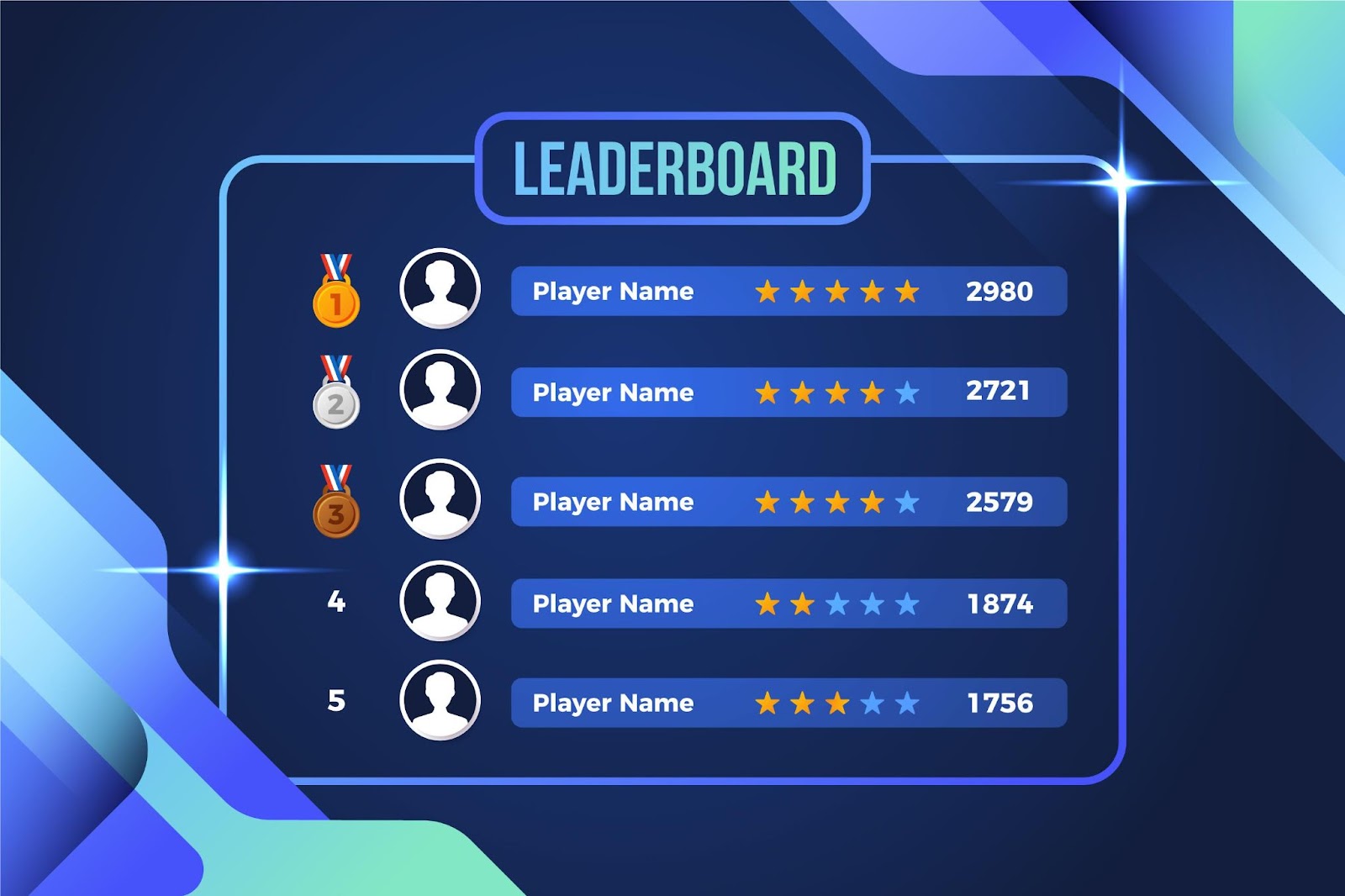Leaderboards have become a staple in various fields, from education and fitness to business and gaming, as a way to track progress and inspire motivation.
By displaying rankings, leaderboards create a sense of friendly competition, encouraging participants to engage, improve, and reach their goals. Beyond simply showcasing achievements, they provide valuable insight into individual progress and team dynamics.
This article will explore why leaderboards are essential for tracking progress and promoting friendly competition, as well as how they can be used effectively to enhance engagement and performance.
Introduction to Leaderboards
Leaderboards are visual tools used to rank individuals or teams based on their performance in a specific activity, fostering motivation and a sense of achievement.
They display rankings in real-time or over specific periods, providing a clear snapshot of where participants stand relative to others.
Definition of Leaderboards
A leaderboard is a display that ranks participants according to scores or metrics relevant to a particular challenge, game, or activity.
Often formatted as a list or chart, leaderboards are commonly found in gaming, fitness apps, education platforms, and corporate environments to track progress, recognize top performers, and encourage continuous improvement.
Historical and Current Use in Various Fields
Leaderboards have a long history in competitive sports and games, where they highlight top scores and drive player engagement. Today, they’re widely used in digital platforms, from online learning apps to sales performance dashboards, to boost user interaction and competition.
By ranking participants in real-time, leaderboards inspire motivation and provide ongoing feedback, making them valuable tools for both entertainment and productivity-focused applications.
Benefits of Using Leaderboards
Leaderboards are powerful tools for driving engagement and enhancing performance.
By making progress visible, encouraging improvement, and fostering a healthy competitive environment, leaderboards provide benefits that are applicable in various settings, from corporate environments to educational platforms.
Motivation through Visibility of Progress
One of the primary benefits of leaderboards is the motivation they create by making progress visible. When users can see their rankings relative to others, it can inspire them to strive for higher placement.
This visibility of achievements and efforts serves as instant feedback, keeping participants engaged and encouraging continued participation.
Whether in a fitness app where users track personal milestones or a workplace setting that highlights team achievements, leaderboards motivate users by showing tangible progress toward goals.
Encouraging Performance Improvement
Leaderboards can effectively drive performance improvement by setting a standard for success.
As participants view the rankings and see others achieving high scores or results, they are often motivated to improve their own performance to match or exceed the top ranks. In educational settings, for example, leaderboards can encourage students to study harder and complete assignments more effectively.
Similarly, in sales teams, displaying top performers encourages others to adopt successful strategies and enhance their productivity to reach higher ranks. This continuous drive for self-improvement contributes to both individual and collective achievements.
Fostering a Competitive Environment
By fostering a healthy competitive environment, leaderboards create a dynamic in which participants are encouraged to reach their full potential. This environment is particularly useful in workplaces, where friendly competition can energize teams and boost morale.
With the incentive of ranking highly, employees are more likely to stay focused, collaborate, and push themselves.
However, it’s essential to balance competition with recognition for all efforts, ensuring that competition remains positive and supportive rather than overwhelming.
Psychological Impact of Leaderboards
Leaderboards tap into fundamental psychological drivers, making them powerful motivators that influence both individual and team behaviors.
By boosting engagement through gamification and understanding potential downsides, leaderboards can be structured to maximize positive impact.
Influence on Individual and Team Behavior
Leaderboards create a sense of visibility and accountability, affecting both individual and team dynamics. On an individual level, the opportunity to see one’s name ranked encourages personal effort and persistence.
In team settings, leaderboards can strengthen collaboration as members work collectively toward shared goals.
Knowing that their contributions affect overall team ranking can motivate individuals to perform their best. However, it’s important for team-based leaderboards to focus on collective achievements to prevent unhealthy competition among team members.
Boosting Engagement through Gamification
By incorporating elements of gamification, leaderboards make tasks feel more like challenges or games, boosting user engagement.
When users see immediate results or status changes on the leaderboard after an accomplishment, it creates a rewarding experience that makes participation more enjoyable. This positive reinforcement fosters a cycle of engagement, as participants continue to interact with the system to maintain or improve their rank.
In educational or fitness apps, for instance, gamification through leaderboards enhances motivation and makes goal achievement feel exciting and attainable.
Potential Downsides and How to Mitigate Them
While leaderboards can be effective motivators, they may also lead to unintended effects, such as discouragement for those consistently ranked lower. If users feel they cannot reach higher ranks, they may disengage entirely.
To mitigate this, consider implementing tiered leaderboards that group users by experience or skill level, so that competition feels accessible and achievable.
Another approach is to focus on personal progress alongside ranking, allowing participants to measure improvements without solely comparing themselves to others.
Recognizing diverse achievements and effort also helps prevent a narrow focus on top-ranking individuals, creating a more inclusive and supportive environment.
Implementing Effective Leaderboards
Effective leaderboards are thoughtfully designed to promote both motivation and inclusivity. By establishing fair criteria and balancing competition with collaboration, you can create leaderboards that drive engagement while fostering a positive environment.
Criteria for Designing Fair and Inclusive Leaderboards
To design a fair and inclusive leaderboard, establish criteria that accurately reflect the efforts and achievements of all participants. Avoid creating overly complex scoring systems that may confuse users or skew results.
Instead, use clear metrics that align with the goals of the activity, such as completion rates, progress milestones, or consistency in participation. Consider implementing tiered leaderboards or groups based on experience or skill level, which allows participants to compete within comparable cohorts.
This approach keeps leaderboards accessible and gives more individuals the opportunity to excel, reducing the risk of lower-ranking participants feeling discouraged.
Balancing Competitive Spirit with Collaboration
While competition can be a powerful motivator, a healthy leaderboard also fosters collaboration and community spirit.
For team-based environments, emphasize collective achievements and use leaderboards to celebrate shared progress rather than solely individual rankings. To encourage mutual support, add recognition features for teamwork contributions, such as “most helpful” or “best collaborator” awards.
This balance not only preserves motivation but also prevents unhealthy rivalry, allowing leaderboards to remain positive and aligned with collective goals.
Conclusion
In conclusion, leaderboards are invaluable tools for fostering a competitive spirit, tracking progress, and motivating users to strive for improvement. This article has discussed how leaderboards not only create a fun, competitive environment but also provide actionable insights into personal and group performance.
By incorporating leaderboards effectively, you can enhance engagement, encourage consistent progress, and create a positive atmosphere of friendly competition. Using leaderboards strategically can lead to improved performance and a more dynamic, goal-oriented environment.
![The Ultimate Guide to the Best Tournament Bracket Apps [2025]](/_next/image?url=https%3A%2F%2Fwebsite-assets.commoninja.com%2Fdistribution%2F1737982824885_Top_5_Tournament_Making_Apps_and_Plugins.webp&w=640&q=75)

